Dishwasher wash cycle or how long the program lasts: an inside look
An actively used dishwasher greatly simplifies the life of every housewife.When choosing this type of household appliance, many focus on appearance, but functionality is more important. To evaluate a model's usefulness, you need to know how long a dishwasher's wash cycle takes and decide whether they're right for you.
You will learn everything about the duration of standard and additional operating modes of dishwashers from our article. We will tell you how to choose equipment with the functionality that suits you personally. Thrifty housewives will find useful tips to reduce operating costs.
The content of the article:
Dishwasher interior
At first glance, the operation of a dishwasher seems simple: install the unit, connect it, put detergents in the right places, arrange the utensils, select a program, start the equipment. Then you can forget about the dishes for a while and do something more enjoyable.
But I wonder what is happening inside the dishwasher at this time? After starting the machine, water flows into a special tray through an open valve. Enriched with detergents and regenerating salt, it heats up to the temperature you set.
The process itself is identical to washing dishes by hand. Detailed design and principle of operation of dishwashing equipment described here. We recommend that you read this very useful information.
It depends on the program you have installed and consists of three to four stages:
- soaking if the dishes are very dirty;
- washing;
- rinsing;
- drying.
The duration of these periods is influenced by the initially set water heating temperature. The higher the threshold you set, the longer you will have to wait for the cycle to end.
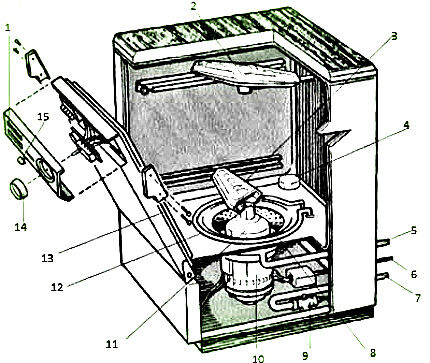
When soaking, which is sometimes called a pre-wash, the main dirt is washed off from the dishes with cold water without the use of chemicals from the main container. This function is convenient if dishes are loaded into the machine in stages as they accumulate. It will prevent dirt from sticking tightly to previously loaded kitchen items.
The washing itself involves treating the dishes with hot water at about 80ºC. You can simply increase the washing time, but the advantage of the first option is that no detergent components are used.
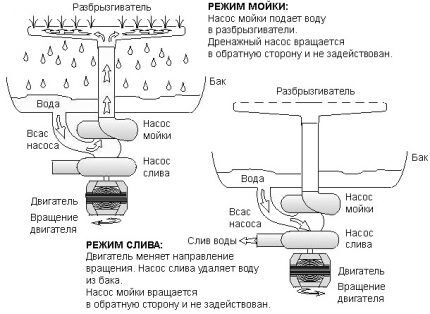
Water along with the chemical composition is sprayed using special tubes located at the top or bottom of the body. The rocker washes dishes more efficiently. During rotation, it sprays water jets in all directions under powerful pressure.
At the end of the washing stage, the PMM automatically turns on the next one - rinsing and drying.

Rinsing in a dishwasher, similar to a washing machine, involves two stages. This is the only way to completely remove detergents from all surfaces of washed dishes.
Standard operating modes
Dishwasher programs are a sequence of operations that the microprocessor performs.
The main parameters are:
- Presence or absence of pre-soaking mode.
- Water heating temperature.
- Duration of the program.
After repeated use of the PMM, it will be easy to recognize how it functions and detect malfunctions by ear.
Types of drying in PMM
Drying completes the washing cycle. It comes in three types: blowing with heated air (turbo-drying), an intensive process with a heat exchanger, and condensation.
The first method involves blowing warm jets of air over the treated dishes. The implementation of the process is possible thanks to the presence of a fan built into the design. Drying occurs faster, but energy consumption is increased.
Enhanced drying is carried out due to the independent movement of air inside the housing as a result of the pressure difference. This method gives good results with more economical consumption of electricity.
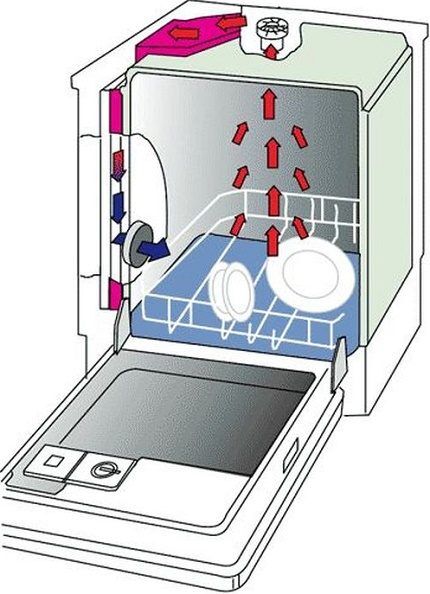
During condensation drying, drops of water evaporating from the surface of the dishes are transformed into condensation and settle on the walls, then flow down. This drying method takes a lot of time, but if there is nowhere to rush, then this method is the best.
Standard cycle time
Modes for different PMM models may differ. Still, there are four basic washing modes in a dishwasher, which each manufacturer includes in its program. These modes are called fast, normal, economical, intensive. Let's look at each of them as guidelines choosing a dishwasher.
When choosing a quick wash, the pre-wash and dry function is no longer required. The process lasts about half an hour. In the instructions for some models, this type of dishwashing is called rinsing. This mode is used when a small amount of not very dirty dishes has accumulated.
In normal mode, which includes a fully completed cycle, the dishwasher runs for an average of two hours, of which:
- Rinsing - from 5 to 10 minutes.
- Main wash — up to 50 min. at a water temperature of 65⁰.
- Rinse in three steps - up to 10 min.
- Drying - the rest of the time.
Economy mode significantly reduces time by increasing temperature and pressure. This results in less water being wasted, but energy consumption increases. The program contains a preliminary rinse, a wash at 50⁰, a double rinse, and drying.
Very dirty dishes are washed using an intensive mode for 2-3 hours. This program includes pre-rinsing, washing at 70⁰, rinsing in four steps, drying.
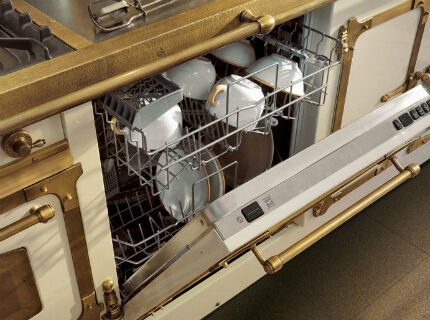
It is better to wash pans and pots in the “pre-soak” mode. Particularly greasy kitchen utensils should be kept in the sink under very hot running water before loading. This will help the dishwasher do a better job.
Some models are also equipped with the following programs:
- EatLoad-Run, allowing dishes to be loaded directly from the dining table. There is a quick wash at 65⁰, then rinsing and drying, and all this in 30 minutes.
- Delicate wash at 45⁰. Used for crystal, porcelain, glass. Duration: 110 minutes.
- Car wash (Auto) — this program, without outside intervention, determines the degree of contamination and automatically sets the required amount of water, detergent and the duration of the process. The usual water temperature in this mode is from 45 to 65⁰, duration is 2 hours 40 minutes.
The latest PMM models have a function Varlo Speed, allowing you to reduce time by up to 50%. Not everything is so simple here - while saving time, electricity consumption increases. When choosing a mode, you need to calculate what is more profitable for you - saving time or energy.
Floor-standing models that hold a minimum of eight sets have half load mode. This means that only one of the available two baskets is loaded. At the same time, the cleaning time is not reduced, but the volume of water, detergents, and electricity used decreases.
Variable wash program provides for simultaneous processes - washing dishes in intensive mode and soaking. These two jobs happen in different baskets. Using the program allows you to save about 25% of water while maintaining excellent washing quality.
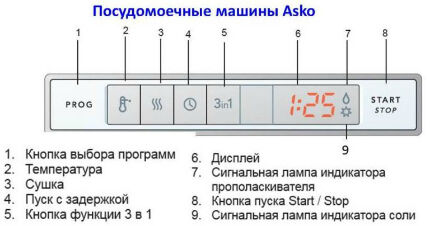
Sometimes the function is very relevant "Delay start". With its help, you can move the start by 1 - 24 hours. If you have a double tariff for electricity, this is very convenient.
Additional functions of PMM
In parallel with dishwasher modes, they can also have additional functions. Almost all of them are equipped with leakage protection. If there are small children in the house, you need a unit with the ability to lock the control panel or door.
The ability to add forgotten dishes after starting the machine is also a very convenient feature. Elite models are equipped with loading sensors. In this mode, the PMM selects both the volume of water and the time spent on the cycle.
Some models have additional elements - sensors for monitoring water purity and hardness. A sensor for monitoring the degree of water purity forces the unit to rinse everything loaded into the machine until the liquid becomes perfectly clean. If the water is very hard, the machine will determine how much softening salt to add.
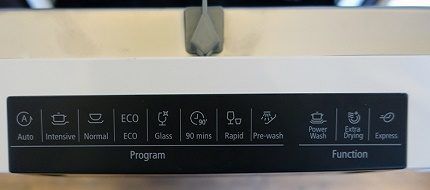
Built-in units in working condition project a red beam onto the floor plane. When the process is completed, it disappears or its color changes to green. This is very convenient, because... allows you to monitor your work built-in dishwasher.
Control of washing modes
All modes in the PMM are coordinated in two ways: electromechanical and electronic. The second method is more comfortable, and all modern models are equipped with it. The first provides for the presence of buttons, switches and keys on the body, and they are controlled manually.
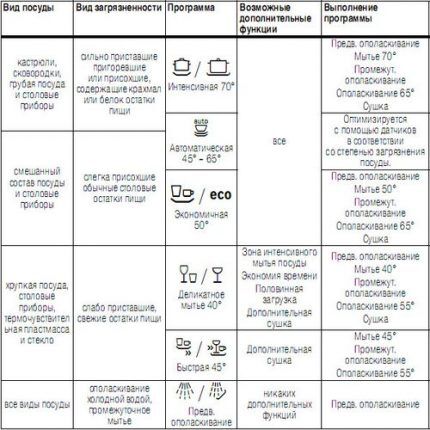
With electronic control, both the washing mode and other programs are set using commands. If the PMM board fails, only a specialist can repair it. Experience shows that most often the programmer will have to be changed.
The final stage of machine operation
At the end of the cycle, the contaminated liquid goes down the drain. This is followed by a drying stage. It can end in 30 minutes or last more than an hour.
A special signal sent by the device will notify you of the end of the program. The sound volume is adjusted using convenient indicators placed by the manufacturer on the control panel. With their help, you can completely disable the alert function if you plan to load the machine overnight.
When the unit stops completely, press the on/off button. Then the door is opened slightly to allow the dishes to cool faster.
After drying, a high temperature remains inside the unit, so it is not recommended to immediately empty it of its contents. In addition, cookware made from certain materials becomes very fragile when hot.

It happens that the cycle is completed, but the dishwasher does not turn off. The most likely cause is an electronic problem. This may also be a consequence of blockage of the drain hole with food debris. The machine cannot shut down correctly.
Program duration for some models
Let's see how the duration of the modes differs for individual PMM models. For this purpose, we will analyze several popular examples of dishwashers of different brands and the duration of washing with these machines.

Based on reviews from many users, we can conclude that the most frequently used modes are fast and intensive.
Water saving level in dishwashers
Both the selected washing mode and the PMM model determine how much water it will consume. On average, this is from 10 to 13 liters per procedure as a whole. Unlike manual washing, all water is used only for its intended purpose without any loss.
During the process, the working fluid is cleaned using special filters and is supplied completely renewed for rinsing. Economy modes reduce the amount of water consumed by 25%.
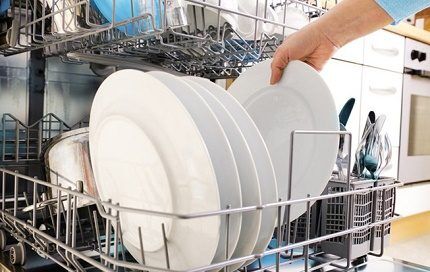
The profitability of PMM is indicated by symbols. Highly economical units are marked with the letters A, B, C. They consume 9 - 16 liters. Average economical dishwashers are designated in the form of the letters D, E.They consume slightly more water - up to 20 liters. Low-efficiency machines with the letters F, G require 26 liters per cycle.
How to load dishes correctly?
Sometimes improper loading of dishes causes the PMM to fail to complete the programs included in it and, as a result, deteriorate the quality of washing. All the subtleties loading dishes into the machine listed in our recommended article.
If you place large kitchen utensils in the center - pots, pans, baking sheets, cutting boards, trays, the flow of water will be blocked. It’s better to move it all closer to the edges or lower it into the lower compartment.
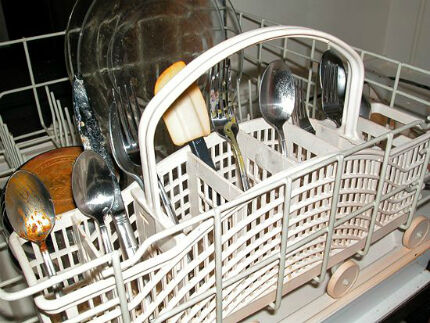
If there is a large amount of dishes that need to be washed, you cannot process them all at once. Water and detergents will not have sufficient free contact with the surfaces of kitchen utensils.
To do this, there must be free spaces between kitchen utensils. If the dishwasher is overloaded, it will not be able to do its job efficiently.
For the dishwasher to function properly, it is important that powder or cleaning tablets were strictly in the compartment designated for this purpose. Due to the fact that the cycle is programmed in advance, all means come into effect precisely at the set time.
If there are streaks on the dishes, this indicates excess salt or rinse aid. When there is not enough detergent, dirty streaks will remain. If you detect food residues at the bottom of the unit and on the dishes, you should check the filters. Most likely they are clogged.Experts advise cleaning them after one or two washes.
Dishes that have not been washed for a long time or that have been burnt on must be pre-cleaned by hand. When excess foam forms during rinsing, it means that you have added too much rinse aid. In this case, correct setting of the dispenser or adding a defoamer in powder form will help.
Conclusions and useful video on the topic
Processes occurring in the machine during operation:
It is difficult to wash dishes by hand in very hot water. PMM does it better. The washing time depends directly on the selected mode and model of equipment. Dishwashing equipment is also supported by the fact that its use not only saves resources, but also the time spent on daily washing of kitchen utensils.
Would you like to share your own experience in operating a dishwasher and choosing the appropriate operating cycle? Is there information on the topic of the article that will be useful to site visitors? Please write comments in the block below, post photos and ask questions about things that interest you.




I read something and my head was spinning... About the automatic mode, when the machine itself determines how to wash the dishes... I don’t understand how it does it. So far, all the associations that there are about automatic modes are the “auto” mode in the camera. Nothing good - average quality without taking into account the features of portraiture or landscape photography. Will there be something similar in the dishwasher - a “medium” mode that will not give perfectly clean dishes?
I don’t know how auto mode works on cameras, but on my dishwasher it’s the main mode, I use it 95%. Cleans no worse than intensive washing. The sensors work great.
There is nothing complicated about the automatic mode of a dishwasher. There is a special aquasensor (turbidity sensor) inside the dishwasher; it sends an infrared beam through the water, which hits a phototransistor. Next, the computer (to be more precise, the microprocessor) of the dishwasher determines the degree of contamination of the water. After each rinse cycle, calibration is performed again until the water is clear.
This is a very convenient mode, although it is not available on all dishwashers. The only thing is that once every few years (4-5) it is worth cleaning this sensor, because over time it becomes contaminated with residues of powder, salt, fats, etc. And
begins to incorrectly detect contamination.
It's always good to know how your home's electrical appliances work from the inside. Understanding how it all works, it is much easier to understand in case of a possible malfunction or breakdown. I usually use two or three dishwasher programs. To be honest, I didn’t even really understand the rest. You will definitely have to find the time, take the instructions and study them carefully.
After reading the article everything fell into place. Thanks to the author. In my practice, there were three dishwashers, now it’s clear why Bosch washes dishes in 2 hours and dries them perfectly. And the Chinese garbage Coopersberg washes for 3.5 hours and the dishes are wet. In my opinion, it is better not to save electricity and enjoy fast and high-quality washing and drying.
Please help me understand the duration of programs for my bosch sps40e12ru dishwasher. The brief schematic instructions show one thing, but in my opinion it works differently. Thank you
Thank you for the informative and insightful article. Manufacturers are laconic in their instructions and sometimes do not give the opportunity to understand the issue thoroughly. For the first time I read about an ion exchanger with a resin(?), which is depleted as it is used. In my Whirlpool, such a procedure for renewing its properties is not described. I'm not sure if it's in the car.